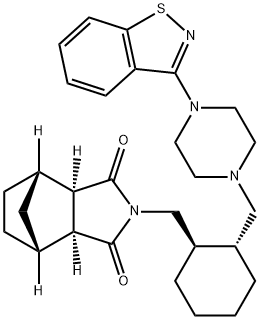Drug for the treatment of schizophrenia
Lurasidone is developed by Japan's Dainippon Sumitomo Pharma which is an atypical antipsychotic,and is a classification of drug registration 3.1 class, it is suitable for the treatment of patients with schizophrenia. Its efficacy is Determined in four six weeks in adult patients with schizophrenia controlled studies. The exact mechanism of the treatment of schizophrenia, like other atypical antipsychotics ,is not very clear,and may be related to the antagonism of the dopamine D2 and serotonin 2A (5-HT2A) receptors. For the treatment of schizophrenia, a study has reported lurasidone can improve cognitive function.
October 28, 2010 ,the FDA approved lurasidone hydrochloride (lurasidone HCI) tablets once a day for the first-line treatment of patients with schizophrenia, the trade name is Latuda.
Dosage: The recommended starting dose is 40 mg/d, the effective dose range is 40~120 mg /· d, the maximum recommended dose is 80 mg /· d. It should be taken with food.
Adverse reaction: common adverse reactions are somnolence, akathisia, nausea, Parkinson's disease-like symptoms and emotional anxiety. Lurasidone has no physical dependence, less likely to cause weight gain, it does not cause glucose, lipids (lipids), it changs the period between ECG and QT.
The above information is edited by the Chemicalbook of Tian Ye.
Description
The atypical antipsychotic lurasidone (also known as SM-13496) was
approved in the United States in 2010 as an oral agent for the treatment
of patients with schizophrenia. Lurasidone has potent affinity for D
2 (K
i= 1.7 nM)
and 5-HT
2A (K
i= 2.0 nM) receptors and acts as an antagonist at both
receptors. It is also a partial agonist at the 5-HT
1A receptor and,
unlike other atypical agents, is a potent antagonist at the 5-HT
7 receptor;
both of these activities are thought to confer beneficial cognitive properties.
Lurasidone is further differentiated by its lack of affinity for muscarinic
and histamine H
1 receptors and its weak affinity for the 5-HT
2C
receptor. Antagonism at H
1 and 5-HT
2C receptors has been implicated in
weight gain associated with atypical agents, while muscarinic receptor
antagonism is associated with cognitive deficits.
Definition
ChEBI: An N-arylpiperazine that is (3aR,4S,7R,7aS)-2-{[(1R,2R)-2-(piperazin-1-ylmethyl)cyclohexyl]methyl}hexahydro-1H-4,7-m
thanoisoindole-1,3(2H)-dione in which position N4 of the piperazine ring is substituted by a 1,2-benzothiazol-3-yl group. Lurasidone is used (generally as the hydrochloride salt) as an atypical antipsychotic for the treatment of schizoph
enia.




